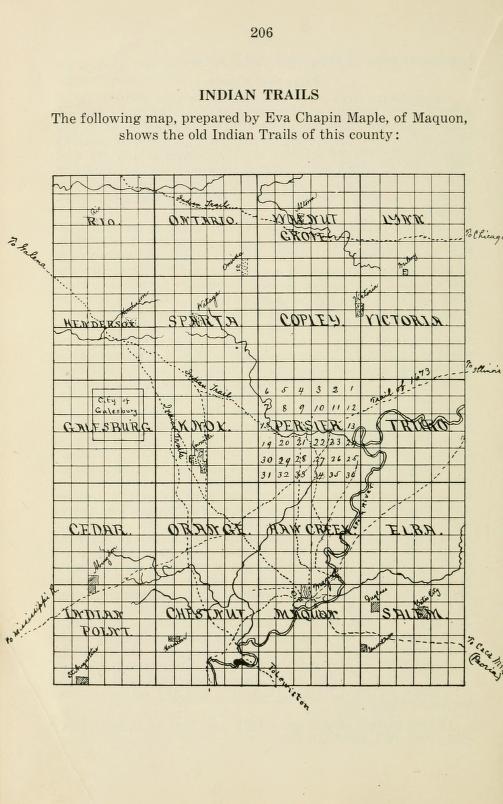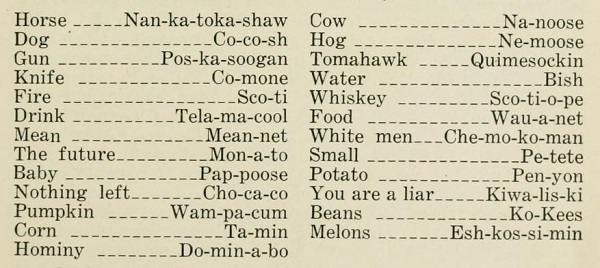1918 Annals - The Indians

In the foregoing township annals, there is frequent reference to the
Indians. The following citations are here used to throw further light on the
tribes that once lived in this county and their methods of gaining a
livelihood:
According to Major Thomas McKee, a pioneer resident of the county: "The
Indians most frequently seen in this locality were Foxes, Sacs, Kickapoos
and Pottawatomies. They were alike in many particulars. The Kickapoos and
Foxes were often in the vicinity of Henderson Grove, which was a favorite
sugar camp. They were as kind a people as you ever saw. They were
considerate. For instance if you were in a wigwam talking, the rest would
keep respectful attention. They did not interrupt you. They made their
children act with deference in the presence of strangers. They did not hunt
perhaps as extensively as some other tribes. They lived on corn and beans,
on berries and other fruits gathered in the woods, while a favorite dish was
the wild potato or penyon, as it was called. This they found in the bottom
lands. It was formerly quite abundant but of late I have not noted it. They
speared and caught fish and now and then secured a deer. The squaws did the
work and it was not until they were aroused by injustice and unkindness that
they became cruel and warlike. The Pottawatomies retained their identity
better than the others.
"The language of these Illinois Indians was simple, consisting of but few
words, made plain by the most significant of gestures. Their names were long
and full of vowels. The following are some of the words used by the
Pottawatomies:
Major McKee was one of those who organized a company and served at the
time of the Black Hawk War.
Eva Chapin Maple, of Maquon, gives in Perry's County History a map of the
Indian trails of the county.
About Their Villages
The following facts are gleaned from a paper read before the Knox County
Historical Society several years ago:
As to the Indian inhabitants of Knox county probably the largest Indian
village in the county was on the Spoon river bottom, near the site of the
present village of Maquon. At different times this village numbered several
lodges and possibly several hundred inhabitants. They raised corn on the
second bottom and for many years after they were driven from this country
they returned at intervals to plant and raise their crops. It was also the
custom to place the bodies of their dead in the forks and tops of trees, but
after the advent of the white people they commenced burying them in the
ground. Another village was at the mouth of Court Creek on Spoon River near
the present village of Dahinda. Mr. Morgan Reece, who came there in the
30's, relates that the lodge poles of the abandoned village were still
standing when he came there and a few families of Indians lived in that
vicinity on Sugar Creek for many years afterwards. The latest family to live
in that section had their wigwams on the northeast quarter of Section 14 of
Persifer township on land now owned by Mr. William Sargent.
Another Old Village
Another old village was situated just southeast of the present village of
Henderson and another in Lynn township at what was called Fraker's Grove.
Persifer township is especially rich in Indian lore and traditions. For many
years the inhabitants of that township have dug in various places for
treasure that is supposed to have been buried somewhere in the township by
the Indians. One legend is to the effect that the Indians were paid a large
sum of money for their land and that they quarreled over the division of
this money and finally fought for it, until, like the fabled Kilkenny cats,
there was none left who knew where it had been hidden, but this was
improbable. Another story as related in Chapman's history of Knox County of
1878 was as follows: "A tribe of Indians settled or located on Court Creek,
Persifer township, whose custom it was to make sugar from the maple trees.
They used brass kettles in which to boil the sap. It seems one spring, after
they had made considerable sugar, they were compelled to leave. Among the
Indians was a squaw and her son called "Bil." This woman had accumulated
great wealth. Not being able to carry all her money, she filled one of her
kettles with gold and silver and buried it on the bank of the creek. She was
afraid of the whites; so after reaching her destination in the West she sent
her son back after her money. Bill made extensive searches up and down the
creek, but failed to find it, and the treasure is supposed to be still
buried somewhere on Court creek. On the Taylor farm, in 1841, a cellar was
being dug, when at a depth of about four feet three bars of copper were
found. These had been forged out by hand. A well was sunk, when down about
22 feet the remains of a camp-fire were found. Charcoal and rubbish were
discovered which plainly proved that at one time, within the life of man
here, that was the surface." An Indian Doctor visited that vicinity a few
years ago, claiming to be a descendant of Black Hawk and pointed out many
places to the inhabitants of Dahinda which had been described to him by his
ancestors who had formerly lived there and in such a way that those who
became acquainted with him were impressed with the truth of his
representations.
Claims Made for Village
Mr. Morgan Reece who collected a great many Indian relics claims that the
village at the mouth of Court Creek was a village of the Sacs and Fox
tribes, and that Black Hawk who was of that tribe had visited that locality.
Relics have been found in that locality that were different from any others
found in this part of the state, but were similar to articles used by the
Indians of the Southern states and on exhibit at the St. Louis Exposition of
1904 and were possibly brought to this locality after being captured in war
or given as a present by some Southern tribe. One relic was made from a
black hard stone. It was about 3 inches long and 2 inches wide and nearly an
inch thick at the broadest part, in shape like the roof of a cabin with a
hole through it lengthwise about where the ridge pole would be. This was
picked up on the banks of Court Creek many years ago.
When Avery Dalton first came to the county, in 1830, there was a
Pottawatomie village at what is now Maquon and near the present bridge
across the Spoon River, they also had a burying ground near Maquon and large
settlements up Spoon River. The Indian cemetery was just east of Spoon River
and about on the present right of way of the Burlington railroad. Until 1832
there were more or less Indians in what is known as Kickapoo Grove near
Elmwood. All of the Indians in that vicinity were of the Pottawatomie tribe.
One of their chiefs who resided at Kickapoo Grove was a very old man at that
time and was known as Captain Hill. He always wore a large silver cross
suspended from his neck by a buckskin thong; many of the Indians wore silver
rings in their noses and heavy ear-rings. They were friendly and great
beggars. They were in the habit of going to Shabbona Grove in the spring to
raise corn, returning in August and September. Mr. Dalton enlisted for the
Black Hawk War shortly after the battle of Stillman's Run and his company
with others formed a battalion of 200 mounted men who ranged over Knox,
Warren and Henderson counties to keep back the Indians from the Rock River
country. During the time they were out the Indians got through the lines but
once and on that occasion murdered a settler in Henderson county. The
company had no fights with the Indians. Most of the members of his company
were from Fulton county.
Many Other Tales
David Dalton, a brother of Avery, was one of the first settlers of Persifer
township and in his day was also a hunter and Indian fighter. There is one
locality in the county which should be mentioned and a thorough examination
of all that pertains to the earliest explorations of the state might throw
some light upon the relics that have been found there. On the northeast
quarter of Section 14, in Persifer township, about two miles north and west
from the mouth of Court Creek where the latter empties into Spoon River, is
a place where in past years many evidences of a battle between large numbers
or of long duration have been found. The place is on the bank of Sugar
Creek, and within an area of a few acres bullets have been plowed up and
found lying on the ground by handfuls. Some few of them were once in
possession of farmers who reside in the neighborhood and they were of the
large, old-fashioned kind, such as were used in the smooth-bore Queen Anne
muskets of two centuries ago.
I had often heard of this so-called old battle field from those who lived in
that vicinity. What called my attention to this particular locality was a
map of the old French trails first traversed in this State. In looking for
information on the subject of this articlest I had occasion to consult among
other books the very excellent book written by Mr. Randall Parrish entitled
"Historic Illinois." In this book is a map of the old French and Indian
trails and one of them leads from the bend of the Illinois river where it
forms the southwestern boundary of Bureau county and about where the
principal town of the Illinois Indians was situated, almost in a straight
line to a point on the Mississippi opposite the mouth of the Des Moines
River. This trail entered Knox county at about the north line of Truro
township and traversed the county in a southwesterly direction passing near
the present city of Abingdon and through what are now Truro, Persifer,
Orange and Cedar townships and crossed Sugar Creek according to the map at
the exact locality of this battle field on Section 14. No other relics have
been found as far as I have been informed, but the large number of bullets
would amply justify the belief that a considerable battle was once waged at
this place. The absence of other evidences, however, is not surprising.
Many other interesting facts about the Aborigines can be found in the Eva
Chapin Maple sketch in Perry's History of Knox county; in the Major McKee
interview and the Judge C. C. Craig paper, on file in the Public Library in
Galesburg; and in Chapman's History of Knox County. Valuable collections of
relics were made by Hon. Rufus Miles, Robert Mathews, Dr. Bedford and others
and many of these indicate a high degree of skill and workmanship. They are
mute evidence of the existence here once of another people who had to give
way to the onward advance of a superior race.
Extracted 15 Dec 2017 by Norma Hass from Annals of Knox County: Commemorating Centennial of Admission of Illinois as a State of the Union in 1818, published in 1921 by the Centennial Historical Association, Knox County, Illinois, The Board of Supervisors, pages 206-211.




